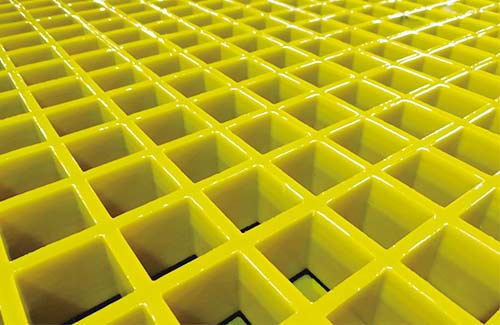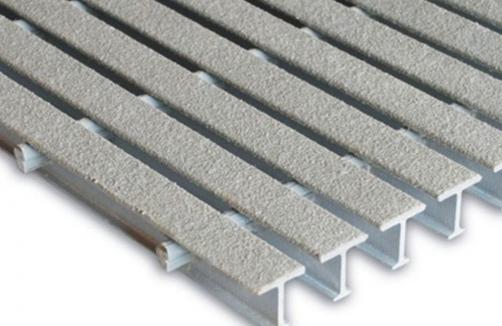In der anspruchsvollen Umgebung von Zementwerken, in denen Förderbänder eine entscheidende Rolle beim Transport von Rohstoffen und Fertigprodukten spielen, ist die Wahl des Materials für Bodenbeläge und Laufstege von größter Bedeutung. Gitterroste aus glasfaserverstärktem Kunststoff (GFK) haben sich als revolutionäre Lösung erwiesen, die eine Vielzahl von Vorteilen gegenüber herkömmlichen Materialien wie Stahl und Beton bietet.
Zementwerke sind durch raue Betriebsbedingungen gekennzeichnet. Hohe Temperaturen, abrasive Materialien und der Kontakt mit Chemikalien sind keine Seltenheit, was die Suche nach haltbaren und zuverlässigen Materialien für Förderanlagen und die dazugehörigen Strukturen zur Herausforderung macht. Herkömmliche Materialien wie Stahl sind anfällig für Korrosion, Rost und Verschleiß, was zu häufigem Austausch und kostspieligen Ausfallzeiten führen kann. Beton ist zwar langlebig, aber schwer, schwierig zu installieren und anfällig für Rissbildung unter Belastung. Diese Einschränkungen haben die Suche nach alternativen Materialien vorangetrieben, und GFK-Gitterroste haben sich als eine hervorragende Option erwiesen.
Einer der wichtigsten Vorteile von GFK-Gitterrosten ist ihre außergewöhnliche Korrosionsbeständigkeit. Im Gegensatz zu Stahl, der korrodiert, wenn er Feuchtigkeit, Chemikalien und rauen Wetterbedingungen ausgesetzt ist, sind GFK-Gitterroste nicht korrosiv. Dies macht ihn ideal für den Einsatz in Zementwerken, wo er ständig abrasiven Materialien, Säuren, Laugen und anderen korrosiven Substanzen ausgesetzt ist. Die Korrosionsbeständigkeit von GFK-Gitterrosten sorgt für eine längere Lebensdauer und verringert die Notwendigkeit eines häufigen Austauschs und der Wartung. Darüber hinaus sind GFK-Gitterroste viel leichter als Stahl oder Beton, wodurch sie einfacher zu handhaben und zu installieren sind. Das geringe Gewicht reduziert die strukturelle Belastung von Förderbändern und Stützkonstruktionen, minimiert das Risiko von Schäden und verlängert deren Lebensdauer. Die Installation ist auch schneller und unkomplizierter, da GFK-Gitterroste vor Ort zugeschnitten und geformt werden können, ohne dass spezielle Geräte benötigt werden, was zu einer Verringerung der Installationszeit und -kosten sowie zu einer geringeren Unterbrechung des Anlagenbetriebs führt.
Trotz seines geringen Gewichts bietet FRP-Gitterrost eine hohe Festigkeit und Haltbarkeit. Er kann schweren Lasten, Stößen und Fußgängerverkehr standhalten und eignet sich daher für den Einsatz in stark frequentierten Bereichen von Zementwerken. Die ineinander greifende Struktur der GFK-Gitterroste sorgt für eine hervorragende Lastverteilung und gewährleistet, dass die Gitterroste auch unter extremen Bedingungen stabil und sicher bleiben. Seine Beständigkeit gegen Ermüdung und Verschleiß trägt ebenfalls zu seiner langen Lebensdauer bei und macht ihn langfristig zu einer kosteneffizienten Lösung. Sicherheit hat in Zementwerken oberste Priorität, und GFK-Gitterroste bieten eine hervorragende Rutschfestigkeit. Seine Oberfläche kann mit einer rutschfesten Beschichtung oder einem Splittbelag versehen werden, wodurch die Gefahr von Ausrutschen, Stolpern und Stürzen verringert wird, insbesondere in Bereichen, in denen sich Förderbänder befinden, was zu einer sichereren Arbeitsumgebung beiträgt und die Wahrscheinlichkeit von Unfällen und Verletzungen verringert.
Zementwerke verwenden in ihren Produktionsprozessen eine Vielzahl von Chemikalien, darunter Säuren, Laugen und Lösungsmittel. GFK-Gitterroste sind sehr widerstandsfähig gegen diese Chemikalien, so dass sie auch dann intakt und funktionstüchtig bleiben, wenn sie ihnen ausgesetzt sind. Aufgrund dieser chemischen Beständigkeit eignen sich GFK-Gitterroste für den Einsatz in Bereichen, in denen Chemikalien gelagert, gehandhabt oder verarbeitet werden, sowie in Bereichen, in denen es zu Verschüttungen und Leckagen kommen kann. Darüber hinaus sind GFK-Gitterroste ein hervorragender elektrischer Isolator, so dass sie in Bereichen, in denen die Gefahr eines elektrischen Schlags besteht, sicher eingesetzt werden können, was besonders in Zementwerken wichtig ist, in denen elektrische Geräte in großem Umfang verwendet werden.
FRP-Gitterroste finden in Zementwerken vielfältige Anwendung. Er wird üblicherweise für Laufstege von Förderanlagen verwendet und bietet den Arbeitern eine sichere und stabile Lauffläche für den Zugang zu den Förderanlagen zur Wartung, Inspektion und Reinigung. Die rutschfesten und korrosionsbeständigen Eigenschaften sorgen dafür, dass der Laufsteg auch in rauen Umgebungen in gutem Zustand bleibt. Zusätzlich zu den Laufstegen für Förderanlagen wird er auch für Plattformen und Zwischengeschosse verwendet, die zusätzlichen Arbeitsraum, Lagerraum oder Zugang zu Geräten bieten. Sein geringes Gewicht und seine hohe Festigkeit machen ihn zu einem idealen Material für diese Strukturen, da er schwere Lasten tragen kann, ohne übermäßig schwer zu sein. FRP-Gitterroste eignen sich auch für die Verwendung als Kanalabdeckungen und Grabenroste. Seine Korrosionsbeständigkeit und Tragfähigkeit machen ihn zu einer dauerhaften und zuverlässigen Lösung, und das offene Design ermöglicht eine effiziente Entwässerung. Um die Sicherheit der Arbeiter zu gewährleisten, können GFK-Gitterroste zur Konstruktion von Maschinenschutzvorrichtungen und Sicherheitsgeländern verwendet werden, die eine klare Sicht auf die Ausrüstung ermöglichen und die Arbeiter vor beweglichen Teilen und elektrischen Gefahren schützen.
Die Installation von GFK-Gitterrosten ist ein relativ unkomplizierter Prozess. Die Gitterrostplatten können vor Ort zugeschnitten und geformt werden, um den spezifischen Anforderungen der Anwendung zu entsprechen, und werden in der Regel mit Schrauben, Klammern oder Klebstoff an der Tragstruktur befestigt. Das geringe Gewicht der GFK-Gitterroste reduziert den Bedarf an schwerem Gerät und spezialisierten Arbeitskräften bei der Installation. Im Vergleich zu herkömmlichen Materialien erfordern GFK-Gitterroste nur minimale Wartung. Seine Korrosionsbeständigkeit bedeutet, dass er nicht regelmäßig gestrichen oder beschichtet werden muss, um Rost und Korrosion zu verhindern. Gelegentliches Reinigen mit Wasser und milder Seife reicht in der Regel aus, um die Gitterroste sauber und in gutem Zustand zu halten, und im Falle einer Beschädigung können einzelne Platten leicht ausgetauscht werden, ohne dass die gesamte Struktur ersetzt werden muss.
Da die Nachfrage nach nachhaltigen und langlebigen Materialien weiter steigt, wird erwartet, dass der Einsatz von GFK-Gitterrosten in Zementwerken zunehmen wird. Die Hersteller entwickeln ständig neue und verbesserte GFK-Gitterroste mit verbesserten Eigenschaften wie höhere Festigkeit, bessere chemische Beständigkeit und verbessertes Brandverhalten. Fortschritte bei den Herstellungstechniken machen GFK-Gitterroste auch kostengünstiger, was sie zu einer noch attraktiveren Option für Zementwerkbetreiber macht.
Zusammenfassend lässt sich sagen, dass GFK-Gitterroste eine Reihe von Vorteilen gegenüber herkömmlichen Materialien für den Einsatz in Förderanlagen von Zementwerken und damit verbundenen Strukturen bieten. Seine einzigartigen Eigenschaften machen ihn zu einem idealen Material für die raue Umgebung von Zementwerken. Aufgrund der einfachen Installation und des minimalen Wartungsbedarfs sind GFK-Gitterroste eine kosteneffektive und zuverlässige Lösung, die dazu beitragen kann, die Sicherheit, Produktivität und Effizienz in modernen Zementfabriken zu verbessern. Mit der weiteren Entwicklung der Branche wird sich der Einsatz von GFK-Gitterrosten wahrscheinlich noch weiter ausbreiten und weitere Innovationen und Entwicklungen in diesem Bereich vorantreiben.







